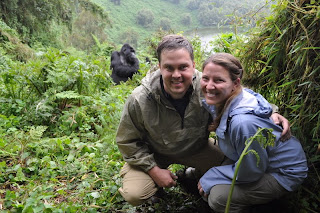


There are 720 mountain gorillas still living in the wild. These are clustered across two mountain systems, one in Uganda (within Bwindi Impenetrable Forest NP) and the other in the border region between Rwanda, Uganda, and the DRC. Gorillas live in family groups, led by one silverback male and several females. Occasionally, large groups can have some "junior" silverbacks, as well, though this doesn't seem to be very common.
Within Rwanda there are fifteen groups, of which seven receive regular visits from tourists. (The rest are visited by researchers only.) This region of the world contains one of the densest human populations on the planet, which has created enormous pressure on the gorilla population. That there are so few remaining is caused by habitat encroachment by humans and by poachers who kill the gorillas (either to prevent them from invading farmland or for food--either way the problem is one of conflict over resources).



So what hope is there for the gorillas? As with many tourist events in Africa, there are two sides to the story. On the one hand, tourism may be the best hope to keep gorillas alive in the wild--it costs $500 per person to visit the gorillas for one hour, and there is significant demand even at that price point. In turn, this income, generated in an otherwise impoverished part of the planet, creates powerful incentives for governments and local people to protect the gorillas--indeed, within Rwanda's Volcanoes NP each gorilla group now has an armed human guard during all daylight hours.
On the other hand, as the gorillas get used to human contact at least two problems arise. The first is that they lose their fear of humans, and in 2007 seven gorillas were murdered in the DRC. The second is that, with shared biology (gorillas share 97% of their DNA with humans) comes shared diseases, and there is a very real risk of
disease jumping between the two populations as they come in contact.



We were lucky enough to visit with Group 13 (named by Dian Fossey as the 13th group she visited, the group actually has 24 members), located between Sabinyo and Bisoke mountains. It's one of the largest groups, with a single silverback hosting ten females and ten juveniles. And we were even more lucky, as the newest member of the
gorilla world was just four days old when we visited.
The trek was really something. We started around 2200 meters elevation and climbed to about 3000 meters, and found the group within the crater of the volcano, a spectacular setting. It's the rainy season here, so it was damp and muddy, but we did not have any significant rainfall during the hike (which was also lucky--the day after it poured and poured). Three hours up, one hour with the gorillas, and two hours down. The photos speak for themselves.








No comments:
Post a Comment